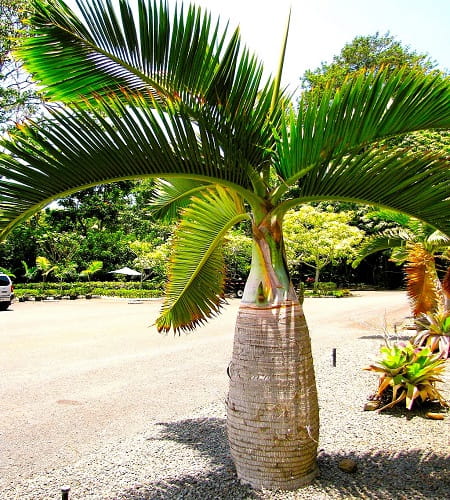- Home
- Caring For Palms
- Maintaining Palms
- Trim Your Palms?
- Self Pruning Palms
Self Pruning Palm Trees
Self pruning palm trees are those that do their own housekeeping!
I wish I could have one that would do MY housekeeping! 😉 But seriously, what does a self pruning palm tree do?
They detach dead fronds when the time is right. For those who love growing their own palms, they save you from the maintenance work of doing it yourself.
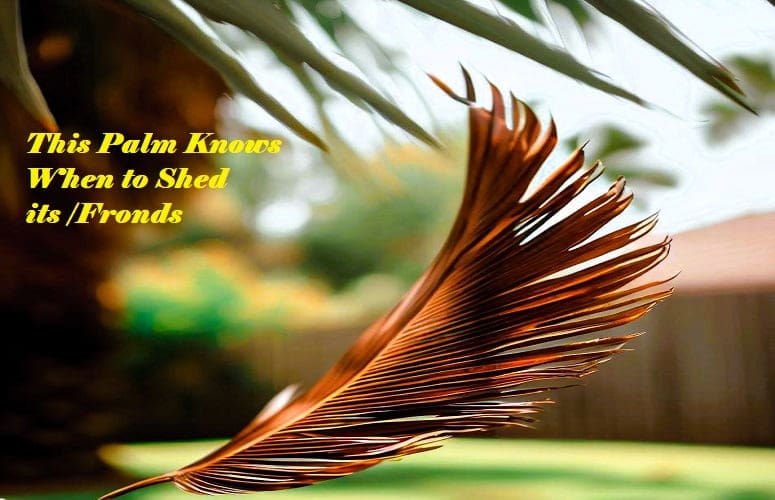
Feeling overwhelmed by so many palm trees?
You're not alone. We Understand your headaches! At Mission: Palm Trees you'll find clear answers to questions & Step-By-Step Guidance, from real people. With solutions to help. No puzzling shoptalk. No tiring research. So it's easy & fun for you.
Which Types of Palm Trees are Self Pruning?
What is an easy way to tell if a palm is self pruning? Any palm plant that has a Crownshaft is a self-pruning palm tree.
A number of palm Genera have crownshafts. Watch for a palm Genus's overall style. If it's described as having a crownshaft, then all species in that Genus will have one. You can then investigate which species you'd like to have.
However, one thing is that's not the only evaluation to consider when you make a purchase.
- It's essential to review climate needs. To know if it's A Palm That Can Grow There, where you live.
- Yes, crownshaft palms don't need pruning!
- But also remember to figure out any other care your chosen species will need. Will you want to attend to those needs? Or maybe not!
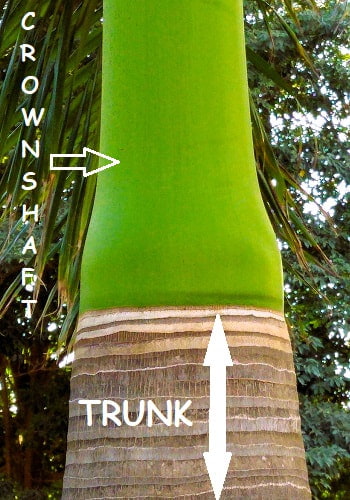 Comparing Crownshaft to Trunk
Comparing Crownshaft to TrunkOn a Royal Palm
Photo: S.Ksiddhartthan - CC BY-SA 4.0 & edited by Site.
Where is a Crownshaft on the Trunk?
Look to the top part of the palm's trunk to find the crownshaft.
It will look distinct from the lower trunk. It's often a waxy, vivid green, but sometimes is another stunning color.
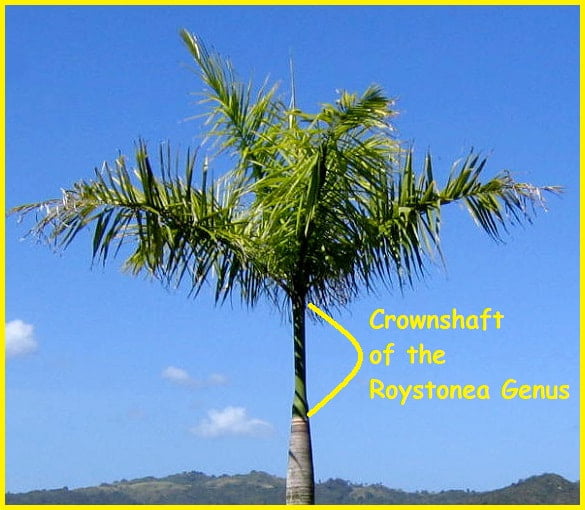 Pointing Out the Crownshaft on a Royal Palm
Pointing Out the Crownshaft on a Royal PalmPhoto: Shoka - CC BY-SA 4.0 & edited by Site.
Lustrous Colors Possible on Crownshafts
An assortment of crownshafts have red, purple, white, orange or brown coloring.
Which then noticeably contrasts with surrounding fronds, and of course, the trunk. Making for a dazzling appearance.
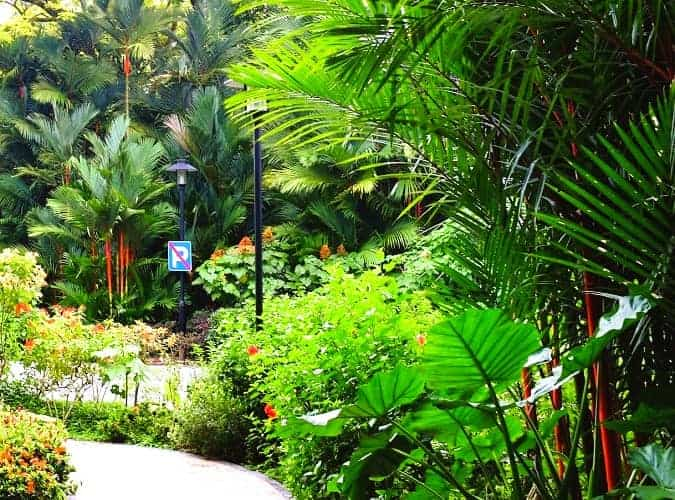 Lipstick Palms Amidst Lush Tropical Plantings at Singapore Botanic Gardens
Lipstick Palms Amidst Lush Tropical Plantings at Singapore Botanic GardensPhoto: Jnz ls Photos * CC BY 4.0
What Exactly is the Palm Crownshaft?
Palm fronds attach to the trunk with a leaf base at the end of the petiole.
Also called a sheath. They're made of sturdy fibers. It helps palm leaves bear stresses, like windy conditions. It's the main anchor system for the frond.
On these palms with crownshafts, this base encircles the trunk. Like a belt circling the trunk. Many fronds help to form the crownshaft. So one after another contributes to its leaf base, giving these sheaths height. They wrap around the trunk securely.
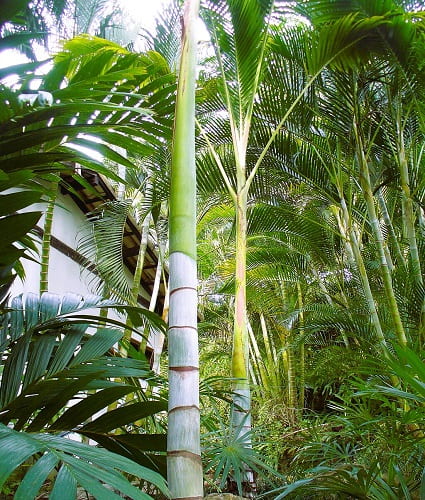 Crownshaft Created From Lengthy Sheaths of Discarded Palms
Crownshaft Created From Lengthy Sheaths of Discarded PalmsOn This Clinostigma harlandii
Photo: Scott Zona - CC BY 4.0
How Crownshafts Cause Palms to Prune Themselves
As a palm ages, fronds will die.
The oldest leaf dies, normally at the bottom of the crown. And at the top part of the crownshaft. Then its crownshaft sheath (which had formed around the top of the trunk) weakens.
Since it can't anchor so well anymore, it begins to split. Until eventually the sheath loses its grip on the frond. The dead frond then falls off the palm.
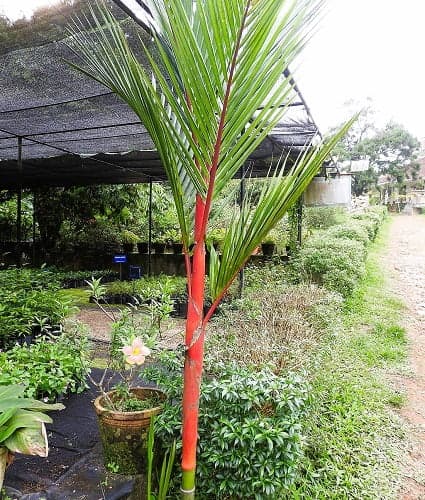 The Lipstick Palm Has Reddish Rachis & Sheaths
The Lipstick Palm Has Reddish Rachis & SheathsWhich Makes a Reddish Crownshaft
Photo: Yercaud elango - CC BY-SA 4.0
Newest Palm Article
-
Palm Tree Care in Winter - Keep Your Palm Safe!
Palm tree care in winter is important if you live anywhere temps dip to near freezing or below. See all you need to feel relaxed in winter weather.
Compare These Self Pruning Palm Trees
Areca Palm
Dypsis lutescens is also called Butterfly Palm, Yellow Bamboo Palm & Golden Cane Palm.
Leaflets have dark green upper surfaces & are silvery below. They attach to the yellowish rachis.
Overall height can get to 40'/12m tall.
- The crownshaft gets about 3'/60cm high. Its lower part bulges a bit.
- Grayish to silvery coloring may have a slight green tinge.
- A clustering palm. So each stem has its own crownshaft.
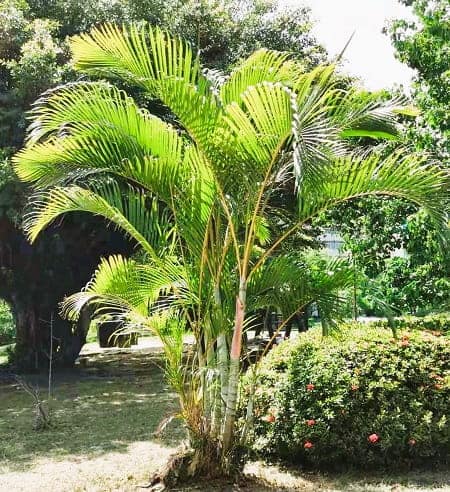 This Butterfly Palm's Crownshaft Has a Pinkish Tint
This Butterfly Palm's Crownshaft Has a Pinkish TintSpecies Coloring Depends on Exposure to Light
Photo: Ping An Chang - CC BY-SA 4.0
Barbel Palm
Acanthophoenix rubra is also known as Red Palm. A shorter solitary, getting to 40'/12m.
- Crownshaft is deep reddish brown. About 3'/90cm in length.
- It's a colorful, a smaller reminiscent of the Coconut palm. Best in Zones 10b-11.
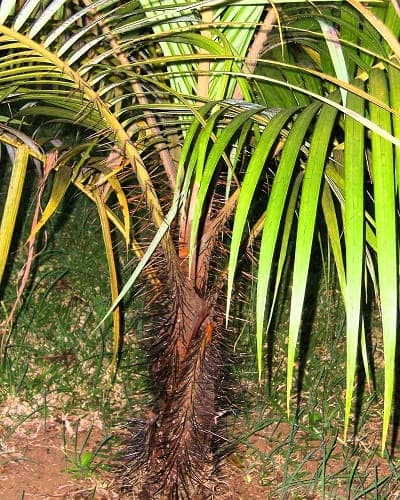 Red Palms are seriously endangered.
Red Palms are seriously endangered.Photo: B Navez - CC BY-SA 4.0
Bottle Palm
Hyophorbe lagenicaulis is a stunner. Named for its round bottle-like lower trunk. It gets about 40'/12m tall.
- Crownshaft rises above the unique trunk. For about 3'/90cm. Mint green in color.
- Native to Mascarene Islands, it's suited for Zones 10b-11. Warmest of 10a can try.
- Dark green leaflets rigidly grow upward from the rachis.
Christmas Palm
Adonidia merrillii has an attractive crown. Its full height can get to 30'/9m. Good form Zones 10-11, but use caution in 10a.
- Its 1-3'/30-90cm high Crownshaft varies in green coloring.
- Around December, produces oval, large red fruits, contrasting against the greens. Giving it that common name. Even so, don't let it get frosty!
- Also often used as a Potted Indoor Palm.
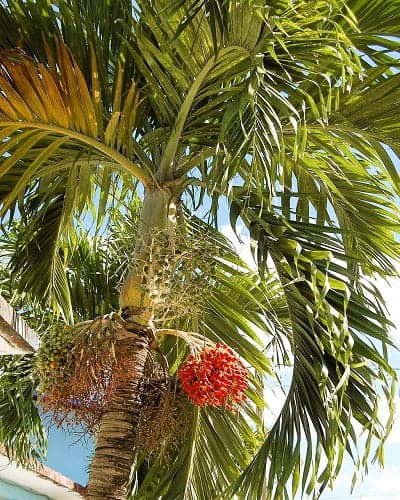 Also called Manila Palm.
Also called Manila Palm.Photo: Michel Chauvet - CC BY-SA 4.0
Foxtail Palm
Wodyetia bifurcata is a faster growing palm. Gets about 60'/18m tall.
- Green crownshaft sometimes has a bluish tinge. 3'/90cm in height. It bulges a little at the bottom.
- Tightly packed leaflets are light to dark green. The feathery fronds are reminiscent of a fox tail, hence its common name.
- Contrasting, the Foxtail Palm has small fruits, vivid red or orange when ripe.
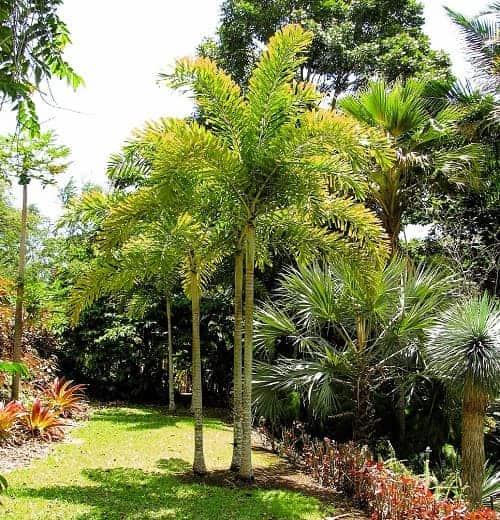 Looking Gorgeous in Maui's Tropical Gardens
Looking Gorgeous in Maui's Tropical GardensPhoto: Forest & Kim Starr - CC BY 4.0
Lipstick Palm
Cyrtostachys renda's other common name is the Sealing Wax Palm. It's a clumper suitable to Zone 11, some 10b.
- Its crownshaft is bright red, about the same thickness as the trunk below. A striking feature.
- For further knockout looks, two areas provide the ultimate contrast.
- White flowers contrast with emerald green leaflets.
- Petiole is also brilliant orange/red.
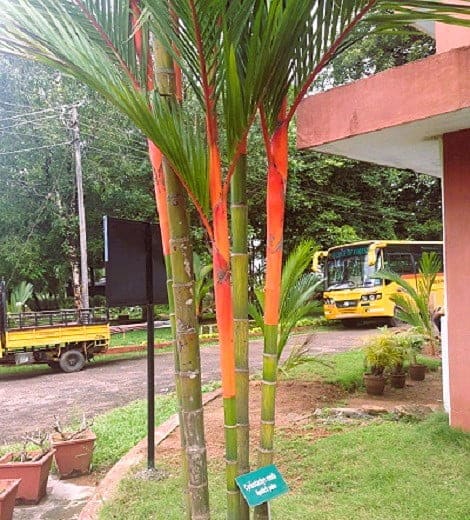 See the striking crownshaft, in brilliant red.
See the striking crownshaft, in brilliant red.Photo: prashanthns - CC BY-SA 4.0
Orange Collar Palm
Areca vestiaria does well in Zones 10-11. Usually a clustering palm. But sometimes grows solitary you may see it called Arica aliciae.
- Some forms grow newest fronds with maroon coloring look even redder.
- Attractive trunks have widely spaced rings white or orange rings. The upper trunk is green. Lower trunk areas are grayish/tan.
- Stilt roots grow from trunk bases.
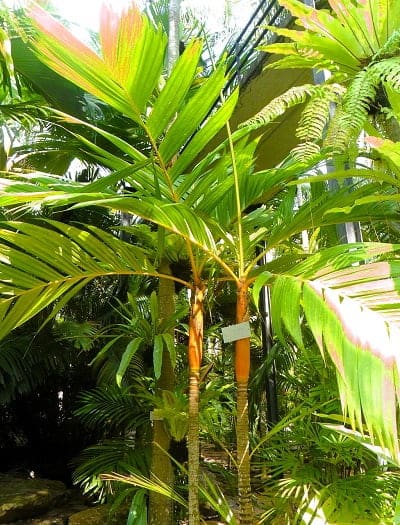 Colorful crownshaft is deep orange.
Colorful crownshaft is deep orange.Photo: Pescov - CC BY-SA 4.0
Royal Palm
Roystonea regia grows tall, to 100'/30m. Native to southernmost Florida, coastal Mexico, Belize & Honduras. Plus Cuba & the Bahamas.
- For Zones 10-11, some 9b.
- Crownshaft tapers at the top. Dark green, about 6'/1.8m tall.
- The trunk is smooth, whitish, some have a gray tinge. The base starts out wide, tapering with height.
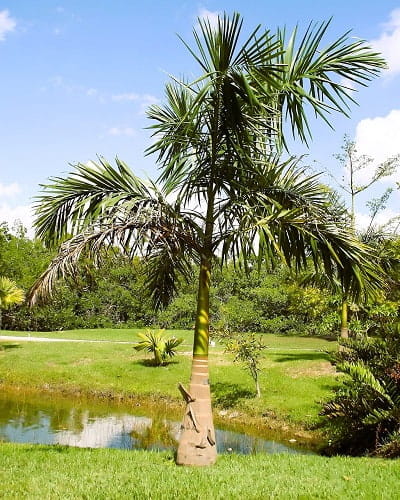 Has widely spaced tan rings on lower trunk.
Has widely spaced tan rings on lower trunk.Photo: David J Stang - CC BY-SA 4.0
Spindle Palm
Hyophorbe verschaffeltii's common name refers to the spindle shaped trunk.
- Bluish green crownshaft swells at its lowest part.
- Inflorescences appear at the trunk's top, just below the start of the crownshaft.
- Up to 40'/12m tall, in Zones 10-11.
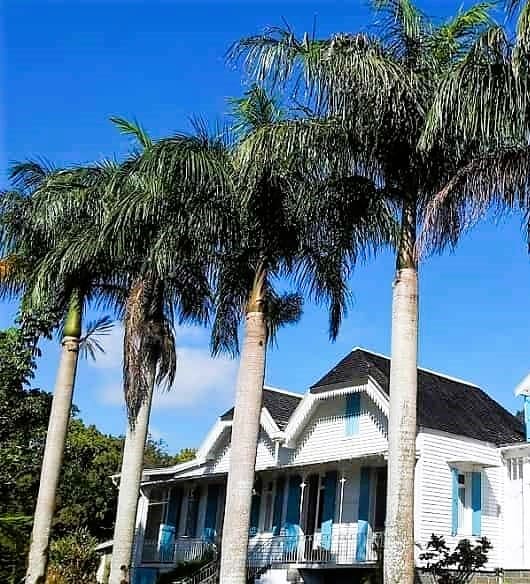 Lined Up Spindle Palms
Lined Up Spindle PalmsTakeaways for Self Pruning Palm Trees
Crownshaft palms may improve palm tree maintenance.
That's because they shed old, dead palms on their own. Many crownshaft species natively grew in tropical rain forest conditions. That's a hint of their climate needs.
Did this give you a good understanding of self pruning palm trees? And the way that they Do That via Their Crownshafts.
You can always Give Us Feedback if you still have questions.

